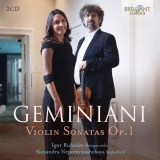Mit diesen Sonaten op. 1 für Violine und Cembalo hinterließ Francesco Saverio Geminiani eine Sammlung, die in ihrer technischen Schwierigkeit an die Werke seines Lehrers Corelli anknüpft. Dabei übernimmt er in der Mehrzahl der Fälle auch die viersätzige Form, in fünf Sonaten beschränkt er sich unter Wegfall des langsamen Satzes am Anfang auf drei Teile, wobei er in der dritten Sonate den ersten Satz mit einer langsamen Einleitung beginnen lässt und in der zwölften Sonate zwei mit Adagio bezeichnete Sätze dem Allegro voranstellt.
Igor Ruhadze tritt immer wieder mit Veröffentlichungen von barocken Werken hervor, obwohl sein Betätigungsfeld weiter gesteckt ist. Mit einem Standbein in den Niederlanden neben Russland ist er musikalische in beiden Welten vertreten. Auch bei diesen Aufnahmen überzeugt er mit seinem unangestrengt fließenden Stil und seiner sicheren Beherrschung der Technik des Geigenspiels. Er hat inzwischen auch im Hinblick auf eine breitere Palette an Ausdrucksmöglichkeiten weiter an Statur gewonnen. So wird diese Gesamteinspielung des op. 1 von Geminiani zu einer lohnenden Beschäftigung mit dieser Reihe, zumal diese Werke im Katalog bisher weniger Beachtung finden als die späteren Opus-Nummern.
Am Cembalo begleitet ihn Alexandra Nepomnyashchaya, die ebenfalls, auch über ihren Ehemann Richard Egarr, im Westen zu Hause ist. Mit ihrem intim selbstbewussten Spiel vermittelt sie dem Cembalo seine grundierend gestaltende Rolle vermittelt. Dies gelingt ihr mit gestalterischer Sicherheit, ohne dass deswegen ihr Instrument anstrengend klingt, was auch schon vorgekommen ist.
With these sonatas op. 1 for violin and harpsichord Francesco Saverio Geminiani created a collection that in its technical difficulty follows the works of his teacher Corelli. In the majority of cases he also adopts the four-movement form; in five sonatas he limits himself to three parts, omitting the slow movement at the beginning. In the third sonata he has the first movement begin with a slow introduction, and in the twelfth sonata he precedes the Allegro with two movements marked Adagio.
Igor Ruhadze continues to emerge with releases of Baroque works, although his field of activity is broader. With a foothold in the Netherlands alongside Russia, he is musically represented in both worlds. In these recordings, too, he convinces with his unstrained flowing style and his secure mastery of the technique of violin playing. He has since continued to grow in stature in terms of a wider range of expressive possibilities. Thus this complete recording of Geminiani’s op. 1 becomes a worthwhile exploration of this series, especially since these works have received less attention in the catalog than the later opus numbers.
He is accompanied on the harpsichord by Alexandra Nepomnyashchaya, who is also at home in the West, also through her husband Richard Egarr. With her intimately self-confident playing, she imparts to the harpsichord its fundamental formative role. She succeeds in this without her instrument sounding strenuous because of it, which has also happened.
























